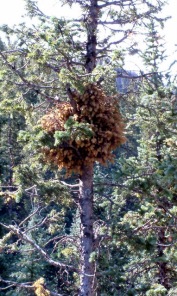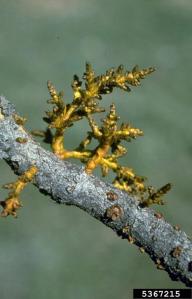
Mistletoe is a holiday tradition. We decorate our doorways with it, where tarrying under a spring might bring you a kiss. Unfortunately, the kind of mistletoe growing along Colorado’s Front Range isn’t so romantic. Five different species of dwarf mistletoe infest pines, spruces and firs. Given enough time, an infected tree will eventually die.
All mistletoes are flowering plants that have given up a life of self-sufficiency to become harmful parasites. Dwarf mistletoes lack leaves, so they have little ability to make their own food from sunlight. Instead of extending their roots into the soil, they have root-like structures that penetrate under the bark, where they siphon off both water and nutrients from the host tree.
The female mistletoe plant produces sticky seeds. When the seed capsules are ripe, usually in late summer, they explode, expelling their contents at speeds up to 60 mph! The seeds can travel up to 60 feet, although 30 feet is more common. Wherever the seeds hit, there they stick.

It can takes a number of years for an infected tree to show signs of distress. The actual mistletoe plants are small to being with, and difficult to see. Instead, look for symptoms such as distorted branches, witches’ brooms, and yellowing or reduced foliage. The tree declines and dies from the top down. This decreased vigor also sends an invitation to Ips and Mountain Pine Beetles, which kill much more quickly.
There is no spray that will kill mistletoe once it has penetrated a host tree. Control an outbreak by pruning out infected branches. You will eventually need to remove the entire tree, but there is no hurry. It is recommended that resistant or non-host trees be planted under the doomed conifer, so they can start growing as replacements.
For more information, see Colorado State University Extension Fact Sheet 2.925: “Mistletoes in Colorado Conifers.”
Mistletoe sprout photo by Mike Schomaker, Colorado State Forest Service, Bugwood.org
